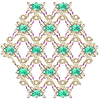issue contents
April 2020 issue

Cover illustration: The introduction of a methoxy subsituent into an aromatic ring of 4-methyl-1,6-diphenylpyrimidine-2(1H)-selenone alters the antimicrobial activities and results in greater selectivity. See Zeslawska, Korona-Glowniak, Nitek & Tejchman [Acta Cryst. (2020), C76, 359-366].
scientific commentaries
Free 

The report of the crystal structure of a new form of [CoCl2(en)2]Cl is both interesting and important as it allows a reassessment of the early work of Werner and brings an emphasis to the occurrence of cocrystals of complexes.
research papers
Download citation


Download citation


Two CdII coordination polymers have been synthesized from 1,4-bis[(1H-imidazol-1-yl)methyl]benzene and 1,3,5-tris[(1H-imidazol-1-yl)methyl]benzene ligands, forming a distorted seven-coordinated pentagonal bipyramidal geometry and a one-dimensional ladder chain with the former ligand, and a six-coordinated octahedral structure with layers connected by hexafluorosilicate anions with the latter.
Download citation


Download citation


Crystallographic studies demonstrated that two 1,3,5-triazine salts derived from 2,4,6-trichloro-1,3,5-triazine and 2-(aminomethyl)-1H-benzimidazole are electron-deficient aromatic systems and that they can interact with electron-rich chemical species. This property makes them potentially useful in the recognition of anions and neutral molecules, and as synthons in the construction of new supramolecular architectures in crystal engineering.
Download citation


Download citation


This work is the first comprehensive summary of noncovalent interactions combined with a library of the supramolecular synthon patterns in all crystal structures of amino acids with the Fmoc moiety reported so far.
CCDC reference: 1951365
Download citation


Download citation


The replacement of the OH group at the C3′ position of a furanose ring by fluorine changes the N-type furanose ring puckering to S-type in the crystalline state.
CCDC reference: 1988181
Download citation


Download citation


A novel three-dimensional (3D) ZnII coordination polymer exhibits excellent photocatalytic activity on the degradation of the organic dyes Rhodamine B (RhB), Rhodamine 6G (Rh6G) and Methyl Red (MR).
CCDC reference: 1945486
Download citation


Download citation


The introduction of a methoxy subsituent into an aromatic ring of 4-methyl-1,6-diphenylpyrimidine-2(1H)-selenone alters the antimicrobial activities and results in greater selectivity.
Download citation


Download citation


A series of tridentate Schiff base ligands has been structurally characterized in the forms of free bases, hydrates/solvates and mono- and diprotonated cations. The most important contribution to the stabilization energy of the crystal is provided by π–π interactions, especially between charged ligands, while the details of the crystal architectures are influenced by directional interactions, especially relatively strong hydrogen bonds.


 journal menu
journal menu

























